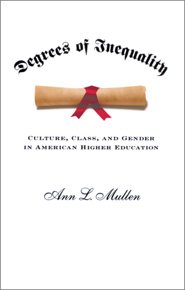Culture, class and gender in American higher education

Ann L. Mullen. Baltimore, MD: The John Hopkins University Press, 2010; 248 pp; ISBN: 978-1-42140-574-2, paperback-on-demand $30 USD.
Recently in the New York Times, under the headline No Rich Child Left Behind, Stanford University professor Sean Reardon had this to say about social class and education: “Here’s a fact that may not surprise you: the children of the rich perform better in school, on average, than children from middle-class or poor families. Students growing up in richer families have better grades and higher standardized test scores, on average, than poorer students; they also have higher rates of participation in extracurricular activities and school leadership positions, higher graduation rates and higher rates of college enrollment and completion.”
This “fact” is the subject of a recent book by Ann Mullen, a University of Toronto sociologist. In Degrees of Inequality Mullen sets out to investigate what she calls the central paradox of higher education in the United States: at a time of dramatically expanded access, the system itself has become increasingly stratified, resulting in a growing inequality of experience and outcomes.
To explore this paradox, Mullen interviewed 50 students at Yale University, a premiere US institution, and, at the other end of the social spectrum, 50 students at Southern Connecticut State University. The two universities are about the same size, are in the same geographical area, and have a mainly liberal arts orientation. While Yale students are among the most privileged young people in the US, Southern Connecticut students come from lower middle and working class families and many are first generation university students.
Mullen’s interviews reveal the inequalities of class that permeate post-secondary education in the US. Yale students tended to have highly-educated parents who had invested heavily in their children’s education, and who had very high levels of social and cultural capital. This is manifest in Yale students’ high ambitions and confidence in their future. By contrast, the families of Southern Connecticut students had fewer financial and social resources and their children articulated much lower academic expectations and ambitions.
While momentous for Southern Connecticut students, the decision to attend university was a natural step along the trajectory of a successful life for Yale students. Students at Southern Connecticut went to university with few expectations, and their educational experience was markedly different from that of the Yale students. For Southern Connecticut students, university was a means to a better career and their courses were chosen with this in mind. Curriculum tended to emphasize applied learning and students were in general not very engaged with extracurricular activities. Many students lived with their families.
Yale students articulated a much different vision and experience and Yale provided an opportunity to explore intellectual life in a rich and challenging environment. Extracurricular activities at Yale were important, along with opportunities for travel and community work. Most Yale students expected to go on to a professional or graduate school.
Mullen provides a compelling portrait of class inequalities and how they are reproduced seamlessly in institutions of higher learning. She sheds light on how class affects choice of institution, curriculum and discipline, all of which are under-researched issues. There are some gaps, however.
Gender is taken up in only a cursory fashion, race merits even less attention, and disability and sexual identity are absent. We learn little about the role of work in student life or about how education is financed — loans and student debt being two issues we would expect to be significant to students at Southern Connecticut. Mullen notes only in passing that many students drop out of Southern Connecticut.
Comparing some of the richest students in North America with the much less advantaged group underscores the inequalities of the US educational system and shows in stark relief how advantage is passed from one generation to the next. Mullen’s broader point, which we reach only at the end of the book, is that as a policy for reducing social inequality, expanding access to higher education is doomed to fail because institutional differentiation simply increases to meet expansion, leaving class inequality intact. As she notes, higher education is no panacea for a society that denies the “reality of acute and increasing social inequality.”
What this tells us about higher education in rich countries other than the US is not so clear. Even among the richest countries, the US is extraordinary and in some respects bizarre, having the highest degree of income inequality and among the lowest levels of intergenerational mobility, along with extraordinary racialized inequality and segregation. Alongside this, the US system of higher education is remarkably differentiated.
While there may be worrying trends, the Canadian system remains remarkably flat. By American standards, the inter-provincial and inter-institutional differences in funding are barely more than rounding errors. Class differentiation still flourishes in our environment, but not quite so visibly. Mullen’s interesting study should direct more of our attention to this issue.
---------------------------------------------------------------
Penni Stewart is a sociology professor at York University and past president of CAUT.